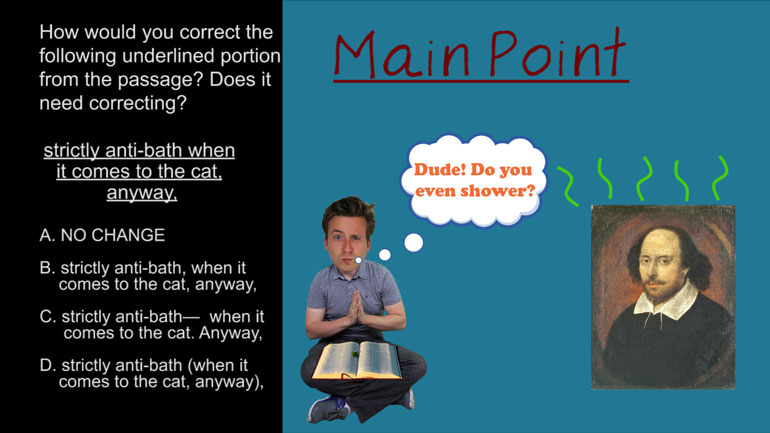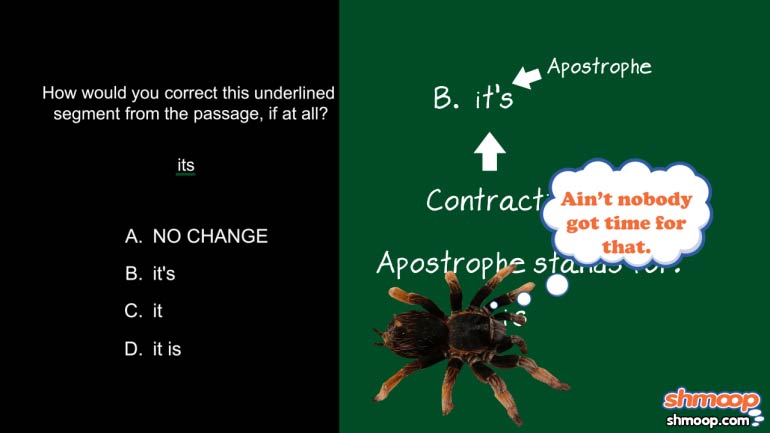ShmoopTube
Where Monty Python meets your 10th grade teacher.
Search Thousands of Shmoop Videos
Colons, Hyphens, and Apostrophes Videos 9 videos
ACT English: Punctuation Drill 3, Problem 1. How should this sentence be changed so that it is grammatically correct?
ACT English: Punctuation Drill 3, Problem 2. How should we properly hyphenate the words in this sentence?
ACT English Punctuation Drill 3, Problem 3. Where should we place the apostrophe to properly indicate possession?
ACT English 2.2 Passage Drill 210 Views
Share It!
Description:
ACT English: Passage Drill 2, Problem 2. What punctuation should be used for a non-essential clause?
Transcript
- 00:03
Here’s your Shmoop du jour, brought to you by hygiene. The good, the bad, and the smelly.
- 00:09
Check out the following passage and answer the question below.
- 00:23
How would you correct the following underlined portion from the passage? Does it need correcting?
- 00:35
"When it comes to the cat, anyway" is a clause that modifies "anti-bath;"
- 00:42
it lets the reader know that the writer appreciates good hygiene, even though he or she avoids washing the cat.
Full Transcript
- 00:49
This is probably an important thing for the author to clarify on a personal level--
- 00:52
especially if he or she is on the dating scene.
- 00:56
Even if it’s an important side-note for the author, the clause is what’s known as
- 01:01
“nonessential,” meaning that it doesn’t affect the core meaning of the sentence.
- 01:05
The main point is to let the reader know the reason why the author avoids bathing the cat,
- 01:11
not to inform the reader about the writer’s bathing routines.
- 01:14
If we’re ever unsure about whether a clause is essential or nonessential,
- 01:17
we like to omit the clause and read the sentence out loud.
- 01:20
Check it: “But the most important reason why our household is strictly anti-bath
- 01:26
is because he hates taking one.” Totally works, right? Nothing super important has been lost.
- 01:32
Knowing that the clause is nonessential helps us to do some eliminating.
- 01:36
For example, we can get rid of choice (A) because it doesn’t separate the clause from the earlier part
- 01:42
of the sentence with any sort of punctuation. Marking nonessential elements this way helps
- 01:46
the reader to understand what’s most important in a sentence. Sorry, nonessential elements,
- 01:51
we know it’s not nice to single people out, but in this case it’s necessary.
- 01:55
Choice (C) is easy to cross out because it breaks up our clause all weirdly.
- 02:01
“Anyway” is essential to this nonessential clause.
- 02:04
So completely separating it with a period makes zero sense and is probably traumatic for everyone involved.
- 02:11
Choice (B) isn’t...you know...wrong wrong. It correctly separates the clause from the
- 02:15
rest of the sentence with commas, which is the most typical method of punctuating nonessential elements.
- 02:21
It also correctly places a comma before “anyway.”
- 02:24
The trouble is that the sentence now looks majorly overcrowded with commas.
- 02:30
Let’s hope there’s a better option on the table.
- 02:33
Yeah, choice (D) is the best answer.
- 02:34
It’s also OK to separate nonessential elements with parentheses.
- 02:38
This works great here because it gets the job done without turning the sentence
- 02:41
into Comma-thon 2014.
- 02:44
We went to Comma-thon 2013, and believe us, it’s way over-rated.
Related Videos
ACT English: Punctuation Drill 2, Problem 2. Where should the semi-colon be placed?
ACT English: Punctuation Drill 3, Problem 1. How should this sentence be changed so that it is grammatically correct?
ACT English: Punctuation Drill 3, Problem 2. How should we properly hyphenate the words in this sentence?
ACT English: Punctuation Drill 3, Problem 4. Which choice best formats this list of items?
ACT English: Punctuation Drill 2, Problem 1. Which choice of punctuation best completes the sentence?










